I’m one-half first-generation American on my father’s side which means that my father’s an immigrant and I, at least by one-half, am an immigrant’s daughter.
I’ve been thinking about that a lot lately, what that has come to mean for me here.
It’s been nearly seven months since I moved to Switzerland, seven months since I filled two suitcases with the majority of my things, seven months since I boarded a plane with the intention of staying put, settling down in an entirely new country, a country that I will, someday I reckon, call home, or at least a second one.
Unlike my father, I’m an ex-pat here not an immigrant. This distinction has always caused eye-rolling on my part, but the difference, as far as I’ve seen, is that I can always go home.
It’s been nearly fifty-four years since my father, let’s call him (as those in his inner-circle [and outer-circle, come to think of it] do) Doc, left his first home. Forty-nine since he emigrated to the U.S., by way of Israel. Thirty-three since he moved from NYC to metro-Detroit, his fourth home.
When people ask me where my last name is from and I say Iraq there’s often a moment: of surprise, of intrigue, of brow-raising, “oh!”. My heritage is Jewish and Christian, not Muslim, and I suppose I look different (and I am, after all, one-half Eastern European on my mom’s side) than the image of Iraqis many people have in their heads .
I suppose the Iraq of my grand-parent’s generation looked a lot different than the image of Iraq I’ve had shelled in my head. I’ve had glimpses of this Iraq, from photo albums, Doc’s recollections; it exists for me, but it’s scattered, dispersed between the covers of newspapers, the footage on the news.
I’ve been thinking of my grand-parents a lot, lately, and how radically their lives changed. My grandmother was around my age when she came to the U.S. I didn’t get to know her too well (she passed on when I was young), but I’ve been thinking about her and how her life took her across the world around the same time that mine has.
This week, I’m making a recipe for her, inspired by her to connect with her and my memories of what we shared.
Mary, born in Baghdad, Iraq, American immigrant, devoted Catholic, mother of four. Do these details really describe who you were?
I have other artifacts, too: a tape-recording of meditative breathing–Som/Om, Som/Om–, an aerobics tape atop your VCR, a glass-jar filled with matchbooks from the places you’d been, a carving of a man and woman intertwined in an embrace on your bed-side-table that would make a nine-year-old me turn pink. An olive-wood rosary, icons of the Virgin Mother. You were deeply religious, but not in the disciplinarian, god-fearing way. More in a close-to-god (I’d even venture goddess, as your icon of choice was a woman) and his/her love kind of way.
Mostly, I remember you through food. The grape-leaves we grew for you, for dolma, beneath the deck of our first home, that sprawling suburb with similarly-drawn houses facing each other across green and marshy lawn. Your similarly green tabouli, drenched in lemon, always in the same banded-glass bowl that I often ate straight-out-of, with a big soup spoon. Kibbeh–olive-oil, cinnamon, salt, the color of soil–which you’d press flat and slice like a pie. A yellow onion, that you’d bite into like an apple.
A big jar of torshi on your fridge-door’s shelf.
Torshi is the word you can use for pickles from tables in the Balkans to those in the Hindu Kush. Recipes differ, but the principle is the same–something preserved, made sour (with salt through lacto-fermentation, or with vinegar) for a tangy addition to your meal.
In Chinese medicine, they say the sour taste is yin, cooling, gathering, absorbent, most active in the liver, strengthening for weakened lungs, “proper food” for the “heartmind.” It organizes scattered mental patterns, collects and holds together what has been dispersed. (Pitchford, 312).
Mary was the daughter of an Armenian orphan, a man whose parents had been killed in the genocide. He grew up in the company of Iraqi Christians–or Chaldeans–and married one. Mary met my Gidu (grandpa in Arabic), a Jewish man, and fell in love. This love would eventually cast them out from their home in Iraq, from Israel (where the Jewishness of the family was called into question), to a place where they could find (at that time) acceptance: the U.S.
Perhaps that is why, as immigrants, ex-pats, immigrants-daughters or grand-daughters or even great-great-granddaughters, we can gravitate toward the sour. A taste to gather, to collect, to hold together what has been dispersed, to bring us together.
Mary’s torshi was made with cauliflower, carrots, cucumbers and cabbage. I used the first turnips and radishes of Spring in my versions. A bright sash of color for a pale-green early Spring.
Ingredients
- Bunch of turnips, sliced thin
- 1/8 of a small beet, sliced thin
- 1.5 tablespoons course sea-salt
- De-chlorinated water
- Bunch of radishes, sliced thin
- Handful of turnips, sliced thin
- 1 small black radish, sliced thin
- 1.5 tablespoons course sea-salt
- De-chlorinated water
Directions
- Sterilize a pint-sized glass jar by filling it with boiling water. Wait a few minutes, then drain. Fill with cold water to cool glass, then drain again.
- Press slices of vegetables into jar until it's full. Add salt. Pour cold, de-chlorinated water (Note: You can de-chlorinate your water by letting it stand for at least 30 minutes) until it covers vegetables. Seal with lid.
Let ferment in cool, dry place for at least 3 days and up to many months. After opening, store in fridge.
References:
Pitchford, Paul. Healing with Whole Foods. Berkeley: North Atlantic Books, 1993, 2002.
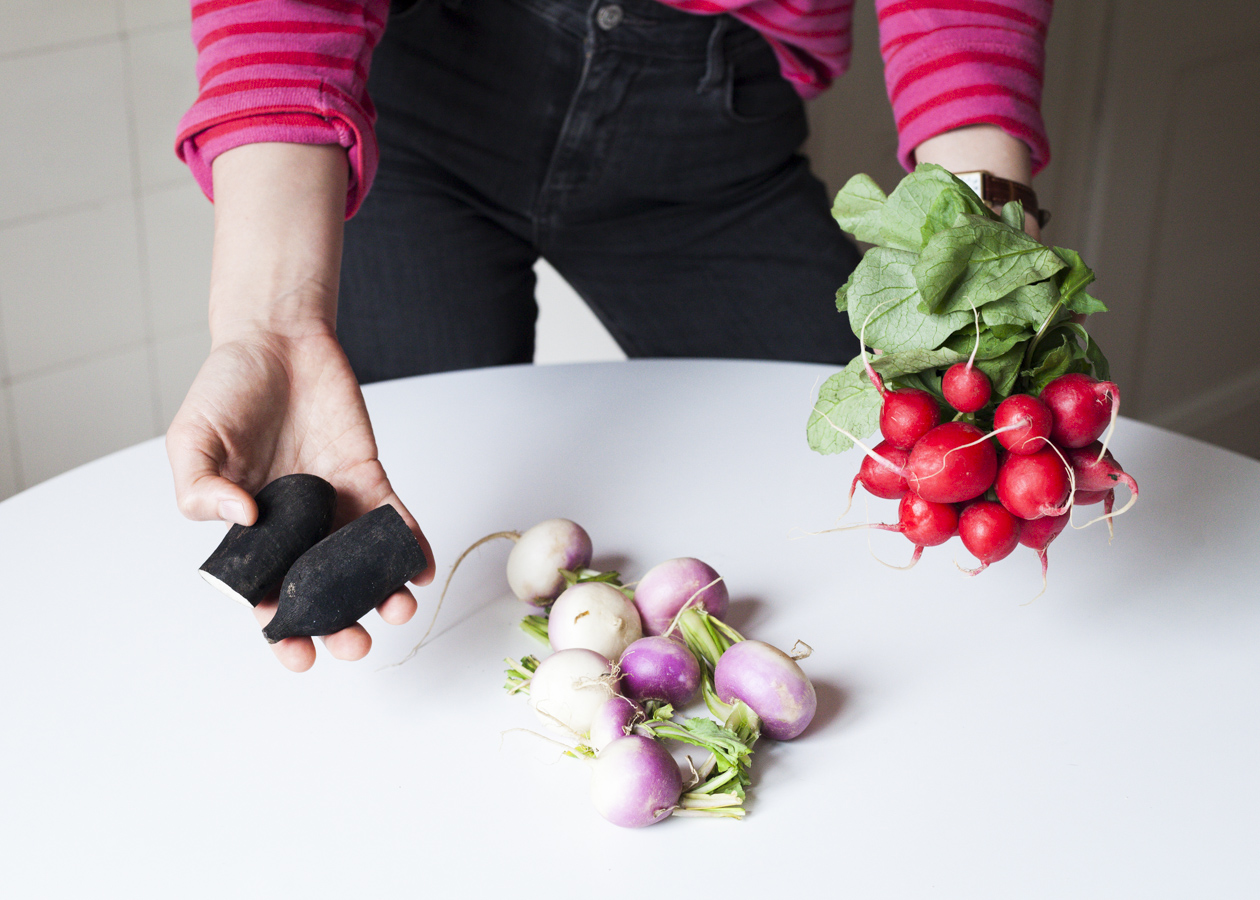
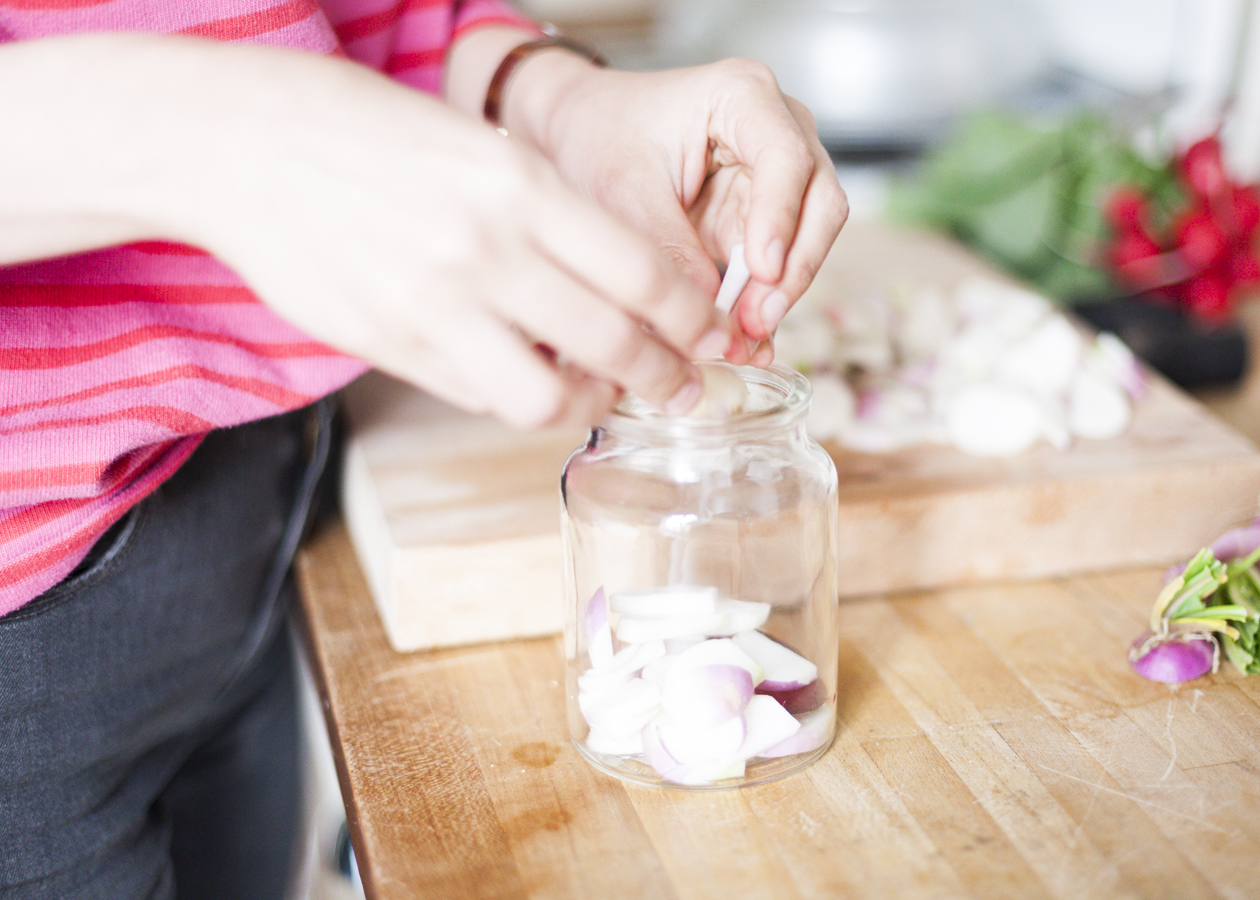
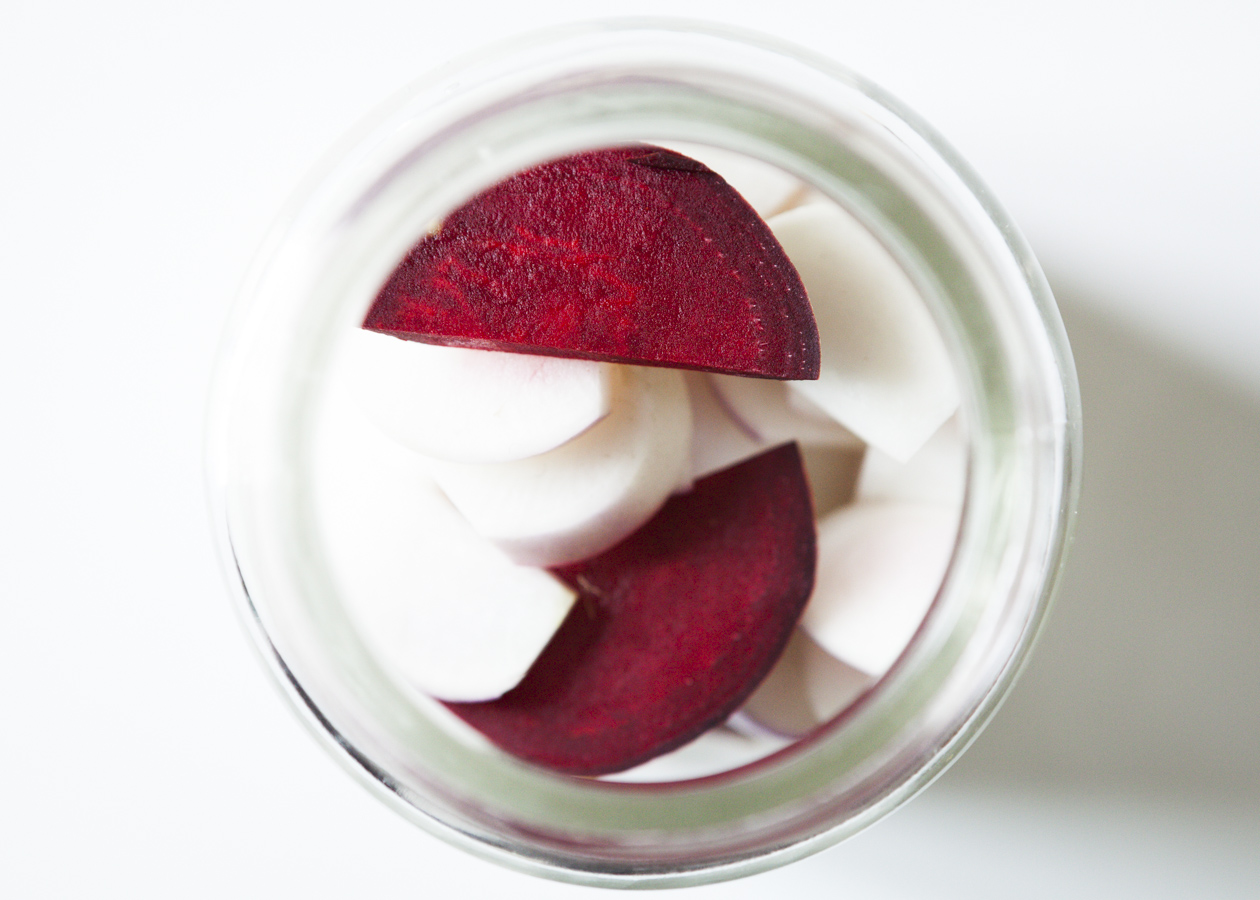
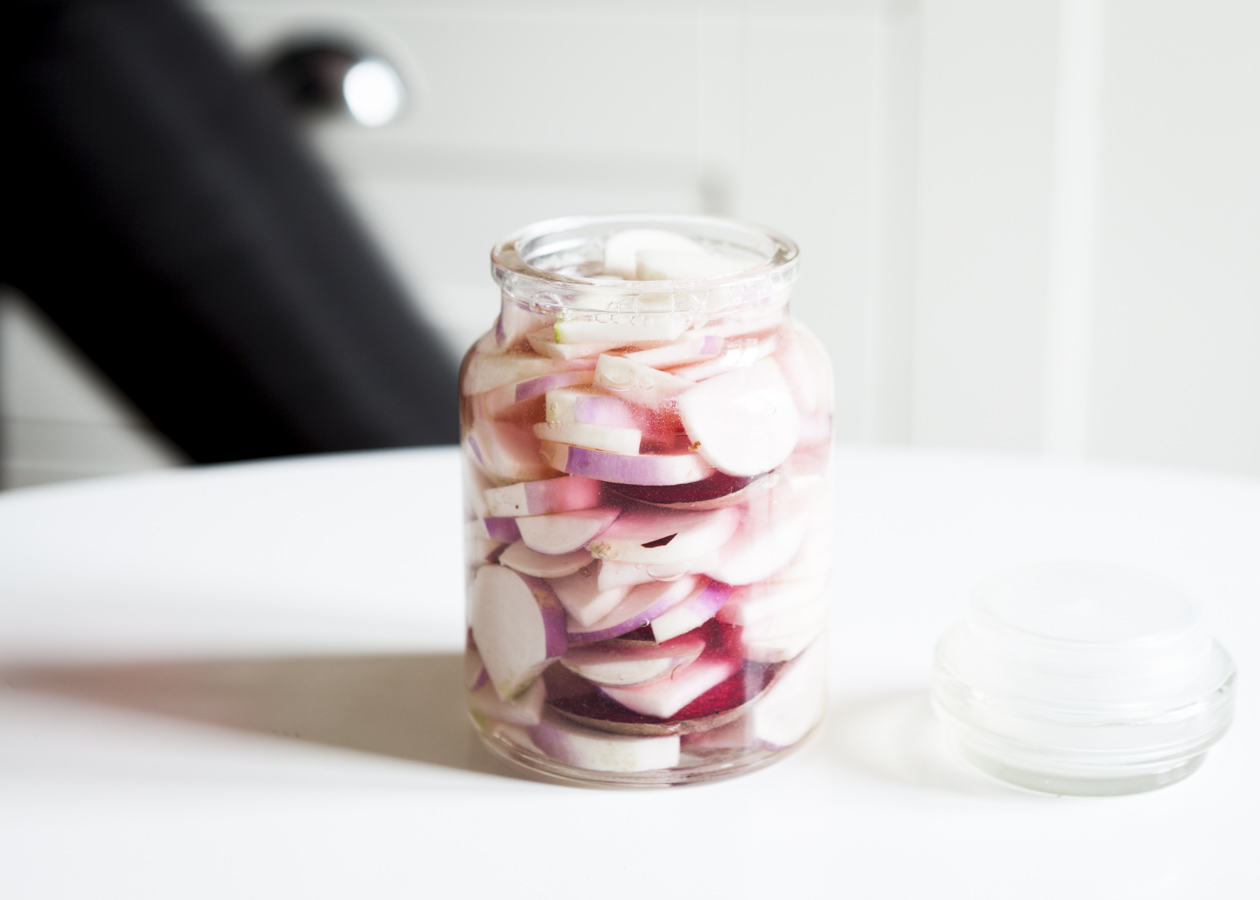
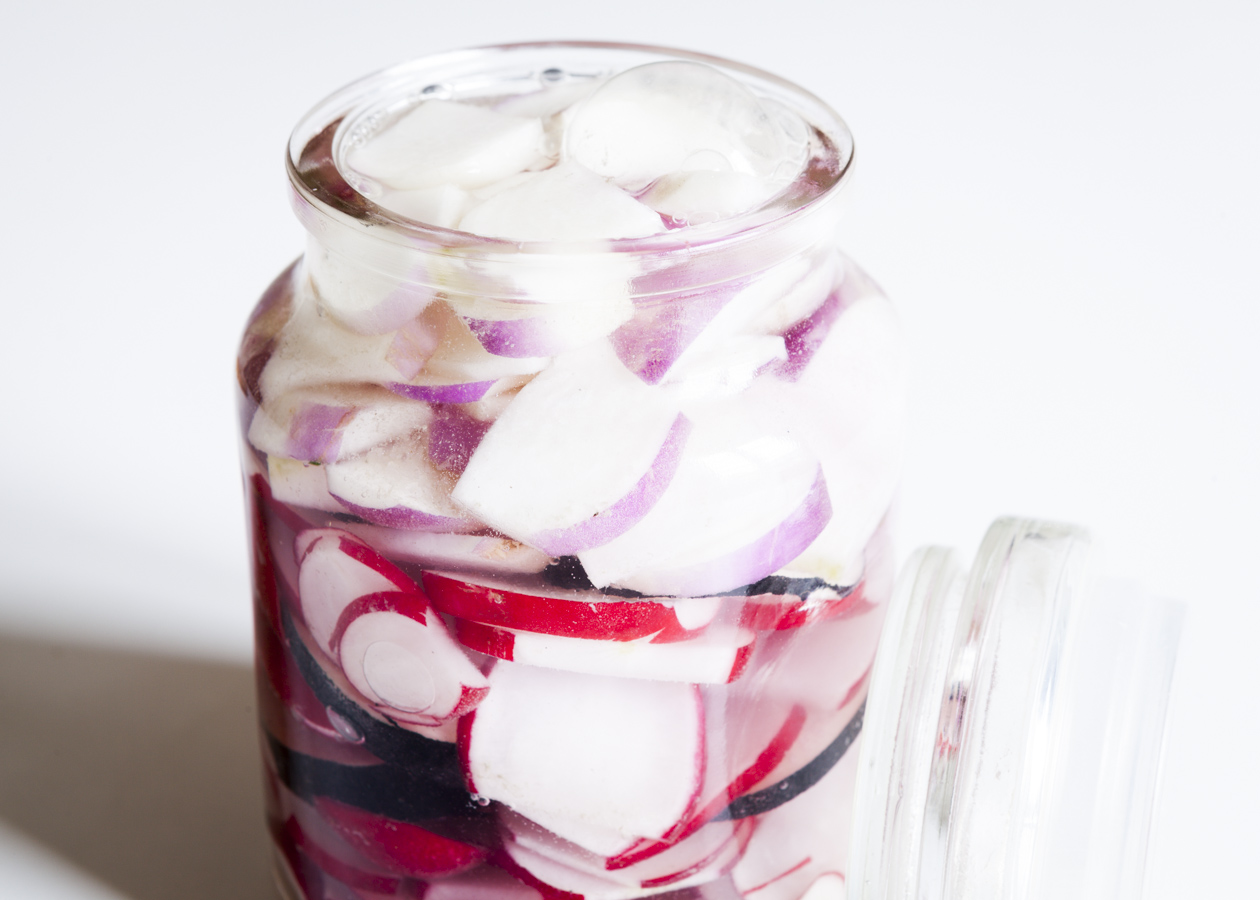
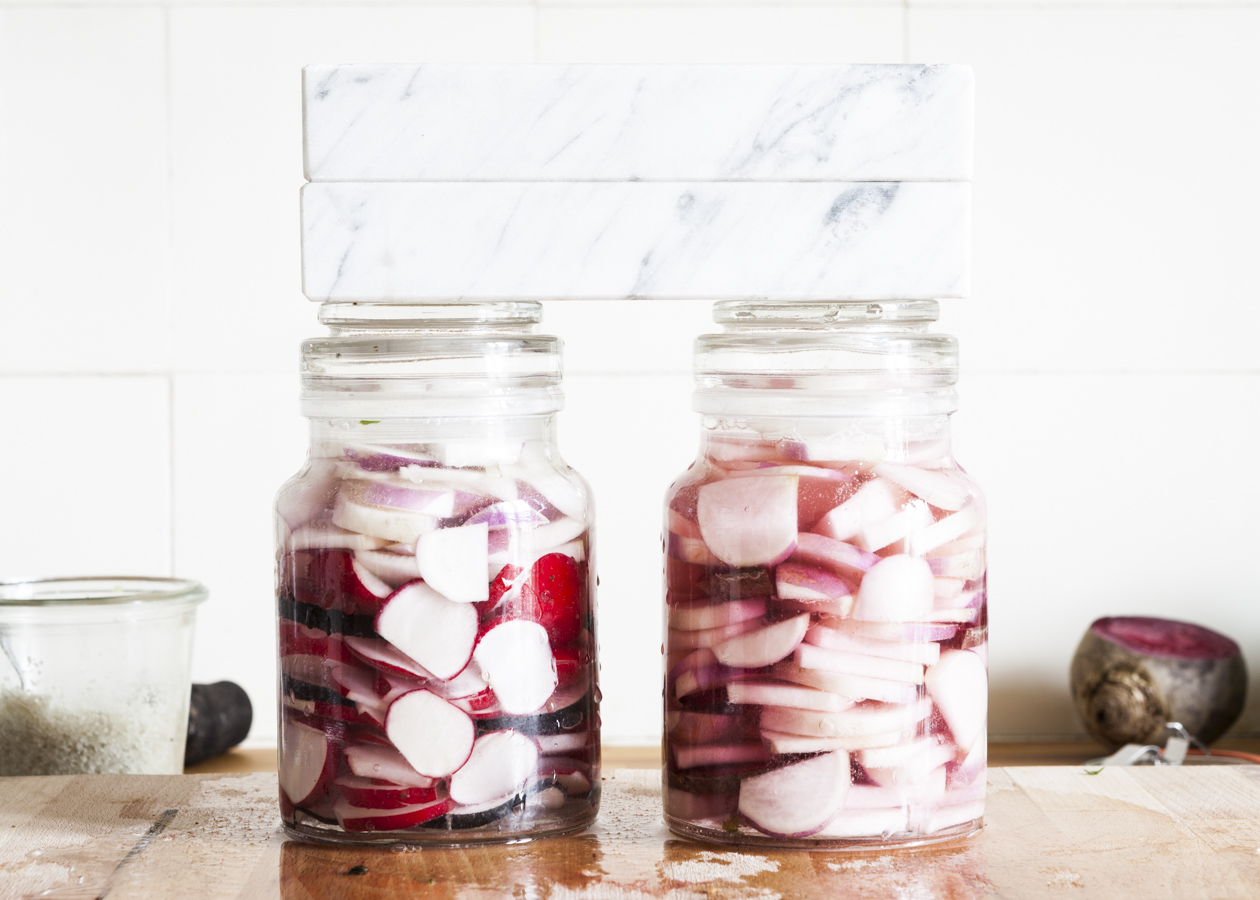
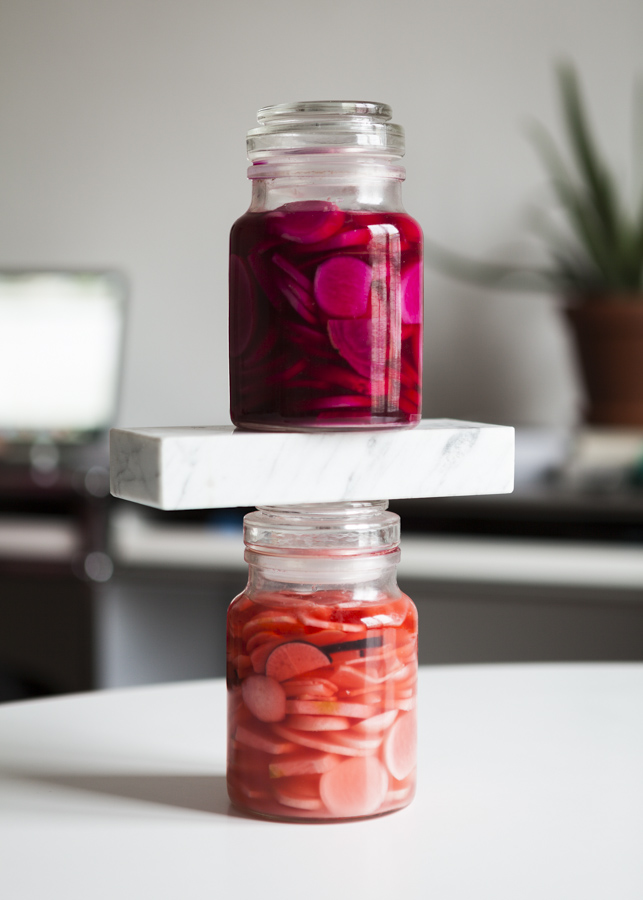
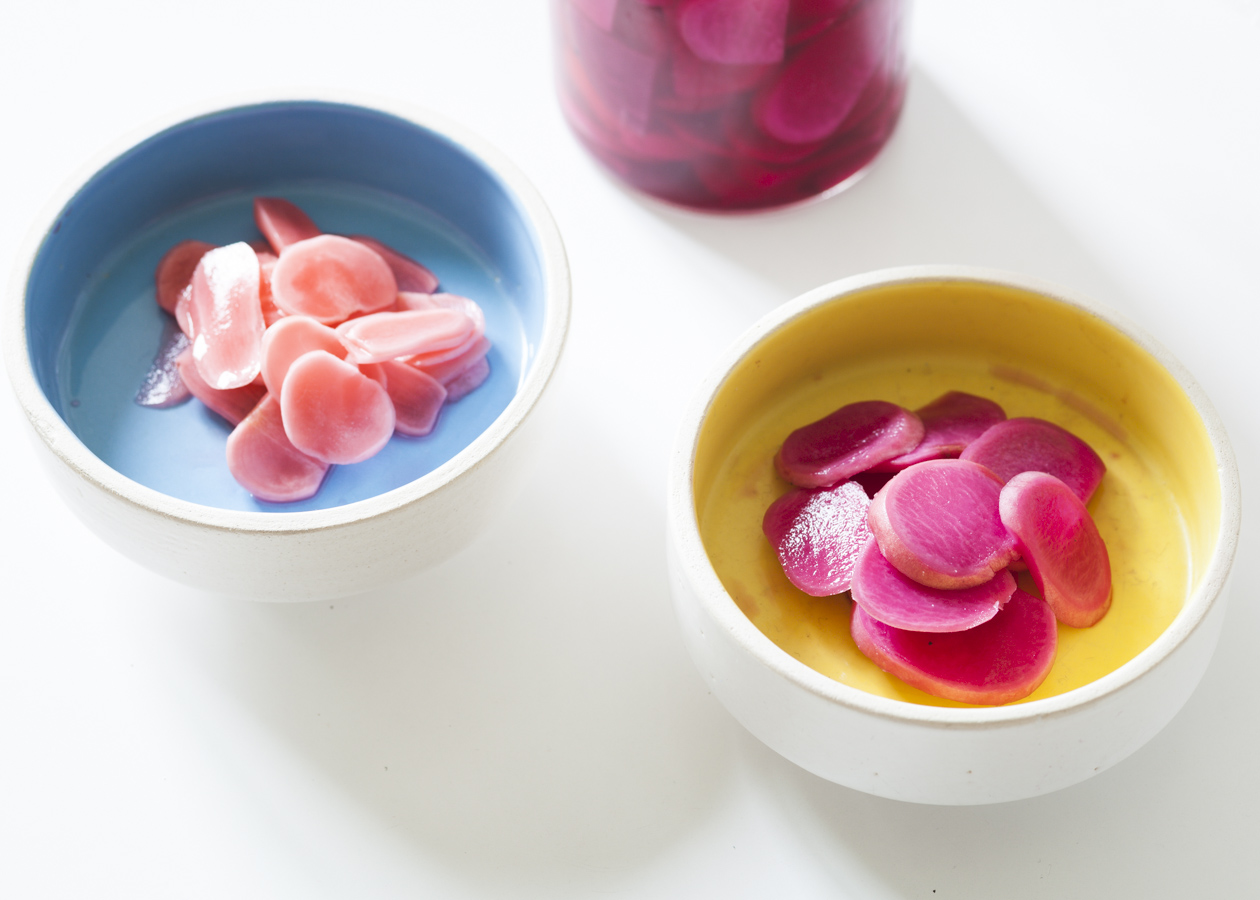
What a rich and complex history you have, and what a lovely post. I’ve been following along since I found your blog a few weeks ago, and now I feel compelled to leave a comment 🙂 I love radishes, and am trying my hand at growing some this Spring for the first time. I will definitely try this when I get my first crop!
Hi Kristin & welcome! Really glad you commented because it led me to your beautiful blog. Fantastik to meet another American living on this Euro-side with a shared love for food & conversations about food :-p Have you found ways to engage those passions in yr community in Sverige? (Still navigating that here in Switzerland, myself). I lived in Sweden for a too-short time a few years ago & your recipes & stories definitely tugged some heart-strings for that sweet place.
& yes, pickle those home-grown radishes!
Puss/kram <3
Yes, it’s nice to meet people in the same time zone! 🙂 Leading a pretty introverted life here so far, but I hope to collaborate with some locals in the future when the blog is a bit more established. Yeah, Sweden is pretty great; I spent a few years in Denmark as well. I need to do a bit more exploring around the country. Some road trips are in order 🙂 I definitely look forward to more posts from you! And if I get around to pickling some radishes, I’ll let you know 🙂 xo-
Beautiful article! Have you made torshi with the other vegetables you mentioned, using the same proportions of salt to water?
Hi Faye and thank you!
I have, indeed, made torshi with lots of other vegetables using the same proportions of salt to water, but there’s also definitely room for experimentation! The more salt you add, the more sour your torshi will be — If I’m pickling cucumbers, for example, I add more salt because I like them xxxtra-sour.
I wrote a post a while back on how to ferment almost ANY vegetable that might be helpful: http://thesoakedbean.com/2014/09/22/free-form-ferments/
Good luck & let me know how your torshi turns out!
<3
Hello,
I have a question. I was friends with an Iranian family years ago and just fell in love with the food. Their parents would come to visit and bring cookies and treats….chickpea cookies, rice flour cookies,baklava, and candies ….just amazing! !! I learned how to make my own Rose water for the Nan-e Berenji, i make Ranginak, Nan-e Nokhodchi, and other recipes from ‘New Food Of Life’ Persian Cookbook.
Rezas mom showed me how to make Torshi. I looked online to try to order some but it was too expensive when you paid for shipping, so I decided to just start making my own. This Torshi is Eggplant and a variety of other vegetables and herbs. Just amazing and it turned out exactly the same intense gorgeous flavor!!! I made a gallon+ jar of it in September 14′ put it in a cabinet and opened it a month later. My mistake was not putting it into smaller jars in the beginning. She made it in a large jar and i did too. They had 10 people eating it and I have only me…..clearly not thought through. Well heres my question. How long does it stay good in the fridge? As soon as i opened it it went into the fridge, and it still looks great because as im sure you know you never use anything but a clean spoon to spoon some out. I put some in a small jar that is opened frequently, and leave the large one in the back of the fridge and still have half of this large jar left and i want to continue to eat it as long as possible.
Thank you!
Leslie
Hi there,
Thanks for stopping by! It’s possible to make torshi 2 ways: with salt as a preservative or with vinegar. I use salt as it contains beneficial lactic-acid bacteria, but many folks (including my Iraqi grandmother) use vinegar. Salt-preserves last indefinitely. Vinegar-brined torshis do expire, but it would take a lot of exposure to oxygen, heat & light (the three things that any torshi-maker wants to avoid!) to make that happen within a couple of years. When it does expire, your nose will tell you (i.e. it won’t smell like something you’d want to eat.) Safe to keep enjoying it, Leslie! And why not experimenting with salt-brined torshi next time (if you haven’t already)?! <3
Ok great thank you! Yes the eggplant was sliced,salted and let it draw out juices and then diced and simmered in the vinegar and cooled while i chopped up the veggies and herbs and let them dry completely overnight. Filled everything in the jar then added sliced lemons and smashed garlic cloves with half apple cider/half pickling white vinegar and she said to make sure i sprinkled salt at the top and seal it up. I was so happy, it is absolutely addictive!!!! Glad i can keep enjoying it!
best wishes!!!!
Wish i could send you a pic of it!!!
Sounds delicious! Once it’s eggplant season here, will definitely give that a spin. & please send a pic over to thesoakedbean@gmail.com! <3
hi, i was in your “japanese” workshop today in geneva (museum) and i must admit that these jars, even if i liked them during the workshop, are way lot better with the story! I really enjoy our attitude towards food, your creative insight, and your way of using simple ingredients in a natural and simple manner.
thanks. I”ll continue looking at your recipes.
jorge
Hi Jorge,
Thanks for stopping by! I’m glad you’re enjoying my take on food and I’m super glad you enjoyed the workshop. It’s pretty wild how cross-cultural so many foods are, as you can see in the case of these ferments! Enjoy them in good health.
Best!
L